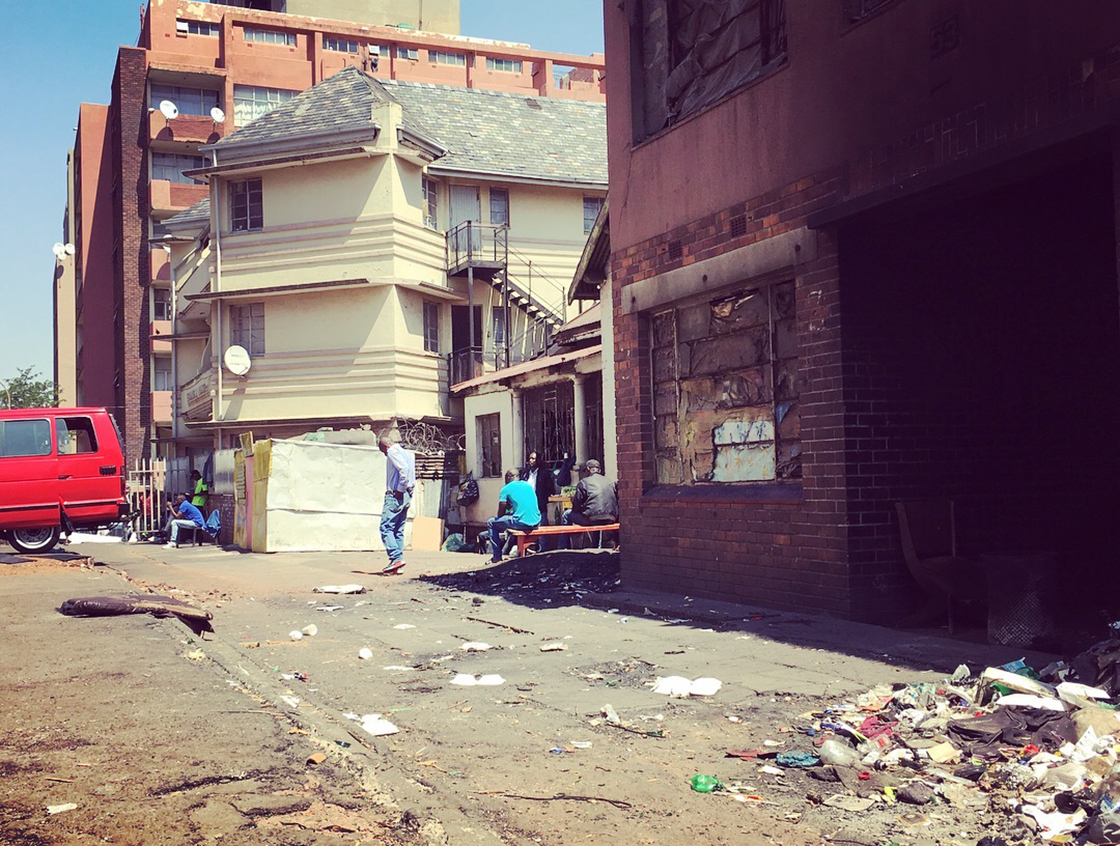Hillbrow
Fragmented Spaces of Suffering and Hope
Hillbrow
Research Diary
While Robben Island is now a monument, a famous shrine of epic import to South African history, other areas remain hidden from public view despite the fact that they are still fighting for the rights of the forgotten outcasts of society. I visited one such a space during a recent research trip to South Africa – a space that gave central Johannesburg its emblematic skyline, a space called Hillbrow.
Originally envisaged as the ‘South African Manhattan’, the district was viewed as a prime location for rich white people who profited from the city’s industrial and mining activities. Yet, as the urban experts, Jonathan Standler and Charles Dugmore point out, the development of the district is characterised by constant shifts in its social fabric: The 1960s notably marked a period of significant infrastructural development. The face of the district was completely transformed by the construction of high-rise offices and apartment buildings. These provided affordable housing for young people, foreigners and rural migrants – a fact that gradually paved the way for the district to become a point of resistance during apartheid in the 1980s. It was during this period that, in addition to resisting the government’s racial policies, the district also became associated with progressive gay and lesbian activism. Hillbrow thus quickly became known as a ‘liberated zone of tolerance and inclusion’. However, by the late 1990s, a period of neglect once again significantly transformed the district. The demography became decidedly less diverse, while extreme poverty gave rise to the area gaining an ungovernable reputation where crime, drug abuse and sex trafficking ruled the day [1]. Contemporary Hillbrow has a similar image where the collapse of practically all services has additionally introduced a certain degree of social chaos heightened by gangsterism and xenophobia. This situation is only aggravated by the sheer concentration of the population. According to the latest census in 2011, Hillbrow is one of the most densely populated areas in southern Africa. It is estimated that roughly 74,000 people live in approximately 200 buildings, many of which are over 15 stories high – all of which are located in a district of a mere square kilometre. Significantly however, the population here almost exclusively consists of rural migrants, foreigners, social outcasts, the economically marginalised and the homeless [2], none of whom enjoy regard for their human rights, neither on the level of national nor on that of local government. As such, contemporary Hillbrow bears evidence of the significant social failures that still exist in South Africa today.
Yet, the way I have come to view Hillbrow is as a multifaceted space that holds as much hope as it does suffering. Those who have nowhere else to go often find their way to the streets and shelters of Hillbrow. It is a place where nobody is judged and many are helped. Yet, it is also a place where every night can be your last regardless of race, age or gender. In this light, Emma Hunt describes Hillbrow as a ‘fragmented space’ of ‘poverty, violence and dysfunction that emerges directly from apartheid and global inequalities [3]’. On the one hand, therefore, contemporary Hillbrow is the direct remnant of a racist past, while on the other hand it also signifies the hidden underbelly of neo-liberal economic oppression.
I found myself in Hillbrow due to a project I am researching related to children in conflict with the law. That is by definition a human rights issue, but can only be identified, approached and addressed through the undergrowth of its social manifestation. Given the information I received from local workers in the field, Hillbrow is facing significant challenges with regard to homeless youths. A national NGO called MES agreed to show me around the district and discuss the challenges they face. Founded in 1986 by members of the Dutch Reformed Church, the NGO works tirelessly to ‘change the heart of the city’ by providing assistance where they can within some of the most deprived areas of the country’s major cities. The acronym MES stands for ‘Mould, Empower and Serve’ and I was humbled by the selfless way in which those I met work to establish a meaningful relationship with the marginalised – with those whom society has chosen to ignore or dehumanise.

Wall of Defiance – Parking Area in Hillbrow

Makeshift MES ‘Field Office’
Saying goodbye to the boys we continued down the road and up a flight of stairs. At the top, we found a blind beggar, whom Ree greeted as a friend. As we continued, Ree told me that the man lost his sight after being beaten up by local members of a gang. Our next stop, was a building dubbed ‘the White House’ of Hillbrow. Yet, it was anything but white. In fact, it was a burnt-out building, with black soot where white paint used to be.




The ‘White House’ of Hillbrow

Othandweni Women’s Shelter – Formally a Dutch Reformed Church
References
[2] Hillbrow: Sub Place 798015088 from Census 2011, http://census2011.adrianfrith.com/place/798015088, Accessed 15/02/2018.
[3] Hunt Emma, “Post-Apartheid Johannesburg and Global Mobility in Nadine Gordimer’s The Pickup and Phaswane Mpe’s Welcome to Our Hillbrow” in ARIEL, Vol. 37, No. 4, 2006.

